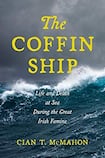
From John Behan’s impressive National Famine Monument at the foot of Croagh Patrick to Joseph O’Connor’s wildly successful novel Star of the Sea, the infamous “coffin ship” has long been emblematic of the Great Famine. Yet its ubiquity as a symbol makes it difficult to develop “a true understanding of the voyage”, as Cian T McMahon argues in this richly detailed and deeply humane book, the first full-length scholarly study of the Atlantic and Pacific crossings between 1845 and 1855.
The Coffin Ship not only examines regular emigrant vessels sailing for North America and Australia, but also includes convict ships. Citing the work of historians Cormac Ó Gráda and Joel Mokyr, McMahon shows that more than 97 per cent of passengers survived the voyage. With the tragic exception of the crossings to Quebec in 1847 that have come to define the memory of Famine-era migration, mortality rates rarely deviated from European averages. The emotive moniker “coffin ship” only became widely used decades later, when Irish nationalists weaponised it as shorthand for the horrors of the Famine.
This by no means implies that the Atlantic and Pacific crossings were without risk or hardship, but, as McMahon argues, taking horrifying exceptions as representative for Famine-era migration as a whole is a “sleight of hand” that homogenises passengers into victims without individuality or agency.
McMahon adroitly weaves together a wide range of sources, including letters, diaries, journalism, shipping notices, guidebooks, tickets, and official reports and correspondence. Throughout, he foregrounds the voices of emigrants themselves, and gives insight into the lived experiences of these Famine refugees during their weeks or months at sea.
The book also sketches broader contexts, such as assisted emigration schemes and the process of deportation, and traces the development of government regulations over the years as authorities sought to improve travelling conditions.
The entire arc of the voyage is covered, from preparation and embarkation to arrival, with two very fine chapters on life and death on board as centrepieces. Naturally, The Coffin Ship includes descriptions of the frequently miserable conditions and poignant accounts of people dying alone at sea or at the Grosse Isle quarantine station in the summer of 1847. It also vividly depicts the land sharks and other crooks waylaying emigrants in their ports of transit or arrival.
Yet McMahon presents other types of stories as well. He describes how passengers sometimes resisted authority en route; how they helped each other; how they publicly acknowledged solicitous captains and their crews; and how they sought to dispel the boredom that defined life at sea.
One of the book's most significant achievements is its argument that the crossing "represented an important moment in the development of diasporic communities". With numerous examples, McMahon shows how transnational networks were crucial at every stage of the voyage. For instance, earlier emigrants often paid the passage for relatives or friends before they left, and gave them advice for the journey. Sending her father in Co Cork a prepaid ticket, New York-
based Margaret McCarthy included the tip to "also bring some whiskey" to make useful friends among the ship's crew.
McMahon states that his research is not concerned with the way the crossing is remembered, but I would nonetheless have appreciated some discussion of how the emigrant ship became the “coffin ship”. As it is, some potentially significant cultural and literary aspects are not given due attention. For instance, a number of the eyewitness accounts McMahon cites appear to have been influenced by published sources in the way they represent the voyage and conditions on board the ship. How and when did such typical modes of representation become popular?
Replicas of two vessels highlighted, the Dunbrody and the Jeanie Johnston, are now well-known Famine museums, which should have merited at least an endnote. The coffin ship also inspired multiple high-profile monuments in Ireland and elsewhere. Some discussion of the work done on Famine memorialisation by art historians Emily Mark-FitzGerald and Niamh Ann Kelly would have been helpful.
All the same, The Coffin Ship is a beautifully executed and highly readable work of social history that critically redraws a central icon of the Famine. McMahon not only sensitively describes tragedies and terrors, but grants his characters individuality, voice and a sense of agency. He also reminds us that the experiences of these Famine refugees should make us more sympathetic towards the plight of today’s refugees.
This book is a vital work of scholarship that will be of great value not only to historians, but to anyone interested in the twin stories of the Great Famine and Irish emigration.










